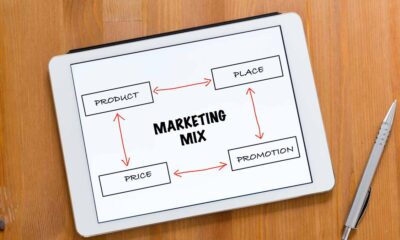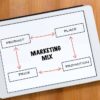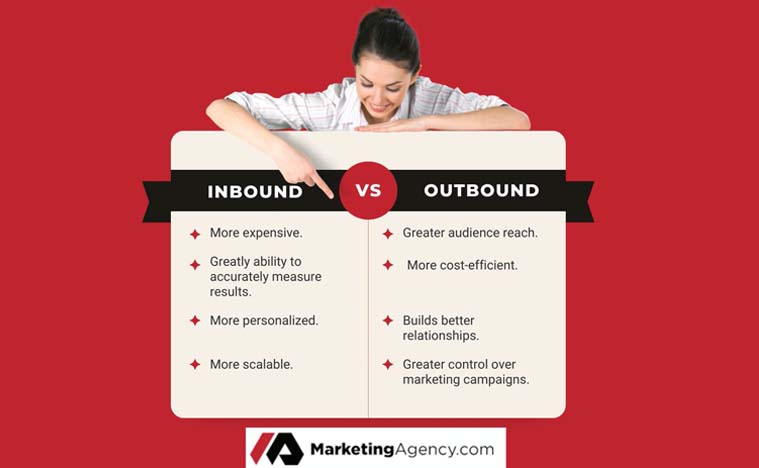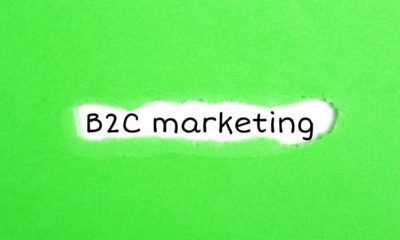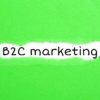Blog
Inbound vs Outbound Marketing Explained
The age-old debate of inbound vs outbound marketing continues. As the landscape of marketing changes, so too does the answer to this question. It seems that every year, the answer changes. However, there are a few constants that can help us determine which method is more effective. Let’s take a look at inbound vs outbound marketing to see which one is more effective for your business.
Differences Between Inbound Marketing vs Outbound Marketing
In the world of marketing, there are two main approaches: inbound marketing and outbound marketing. Inbound marketing focuses on creating content that draws customers to your product or service. This might include blog posts, eBooks, podcasts, or webinars.
Outbound marketing, on the other hand, involves proactively reaching out to potential customers through activities such as cold-calling or unsolicited emails. In order to decide which approach is right for your business, it’s important to understand the key differences between these two types of marketing.
In general, inbound marketing is more cost-effective and leads to higher quality leads than outbound marketing. Inbound marketing also has a longer shelf life than outbound marketing; once you’ve created a piece of content, it can continue to generate leads long after it’s been published. For these reasons, inbound marketing is often the preferred approach for businesses that are looking to generate sustainable growth.
However, outbound marketing can still be effective in certain situations; for example, if you’re launching a new product or trying to reach a new market. In the end, the best approach is often a combination of both inbound and outbound marketing. By using a mix of strategies, you can ensure that your message is reaching the right people at the right time.
What Is Inbound Marketing?
Inbound marketing is a term that is used to describe a marketing strategy that is focused on attracting customers to a company or product, rather than actively seeking them out. Inbound marketing typically includes activities such as content marketing, SEO, and social media outreach. The goal of inbound marketing is to create a relationship with potential customers, and ultimately, to convert them into paying customers.
In order to be successful with inbound marketing, you must first understand the buyer’s journey. The buyer’s journey is the process that your ideal customers go through as they move from being unaware of their problem or needing to become paying customers of your product or service.
Inbound marketing can be an effective way to reach new customers, as it allows companies to build trust and credibility with their target audience. Additionally, inbound marketing is often more cost effective than traditional advertising methods, making it an appealing option for small businesses and startups.
Types Of Inbound Marketing
Now that we’ve got that out of the way, let’s take a look at the five types of inbound marketing so you can start putting together a strategy for your business.
Content Marketing
The first type of inbound marketing is content marketing. This is probably what you think of when you hear the term “inbound marketing,” and with good reason. Content marketing is all about creating valuable content that will attract strangers and turn them into leads and customers. This could be anything from blog posts and ebooks to infographics and webinars.
Search Engine Optimization
If you want your content to be seen by as many people as possible, then you need to make sure it’s optimized for search engines. This is where search engine optimization (SEO) comes in. SEO is the process of making sure your website and its content are structured in a way that makes it easy for search engines like Google to find and index your site. When done right, SEO will help your content rank higher in search results, which means more traffic to your website.
Social Media Marketing
Social media marketing is another important part of inbound marketing. As the name suggests, this is all about using social media platforms like Facebook, Twitter, and LinkedIn to promote your content and engage with potential customers. It’s also a great way to build relationships with influencers in your industry who can help amplify your message.
Email Marketing
Email marketing is a type of direct marketing that uses email messages to promote products or services. Moreover, email messages can be sent to a list of subscribers in order to build relationships, drive sales, or both.
Lead Nurturing
Once you have a steady stream of traffic coming to your website, it’s time to start converting those visitors into leads with lead-nurturing campaigns. Lead nurturing is all about providing valuable information to leads at different stages of the buyer’s journey so they can make an informed purchase decision. This could be anything from an ebook for someone who’s just starting their research to a case study for someone who’s ready to buy.
[Read More] Affiliate Marketing: What Is It & How Does It Work
Advantages Of Using Inbound Marketing
Cost-effective
Inbound marketing is a cost-effective way to reach your target market. With inbound marketing, you can attract leads through your website and social media channels without having to pay for advertising. This means that you can save money on traditional marketing methods, such as print ads and television commercials.
Measurable
Inbound marketing is also a measurable form of marketing. With inbound marketing, you can track the number of visitors to your website, the number of leads generated, and the number of customers converted. This allows you to see which marketing activities are generating the most results so that you can adjust your strategy accordingly.
Personalized
Inbound marketing allows you to personalize your marketing messages to appeal to your target market. With inbound marketing, you can segment your leads and customers based on their interests and needs. This allows you to create more relevant and personalized content that is more likely to resonate with your target audience.
Scalable
Inbound marketing is also a scalable form of marketing. As your business grows, you can easily add more content and strategies to your inbound marketing mix without having to increase your budget. This makes it easy to grow your business without having to invest a lot of money in marketing.
Increased ROI
Because inbound marketing is so effective, it typically has a higher return on investment (ROI) than traditional marketing methods. In fact, businesses that use inbound marketing see an average ROI of 13:1. This means that for every dollar you spend on inbound marketing, you can expect to see $13 in return.
Disadvantages Of Using Inbound Marketing
While there are some great advantages to inbound marketing, there are also some disadvantages to it.
Time-consuming
Developing and implementing an inbound marketing strategy requires a significant investment of time. From creating and publishing high-quality content to promoting it across various channels, inbound marketing can be quite time-consuming. This can be a problem for businesses that don’t have the resources to invest in a long-term inbound marketing strategy.
Can be expensive
While inbound marketing doesn’t require a large upfront investment like traditional advertising, it can still be quite costly. Between hiring skilled marketers, paying for promotional tools, and investing in content creation, inbound marketing can add up quickly. This can be a problem for businesses with limited budgets.
Requires patience
Unlike traditional advertising, which can provide immediate results, inbound marketing takes time to generate results. It can take months or even years to see a return on your investment in inbound marketing, which can be frustrating for business owners who want to see immediate results.
Inbound marketing may not be right for every business
Inbound marketing may not be the best fit for every business. If your target audience is not active online, or if you’re selling a product or service that is not conducive to an online sales process, then inbound marketing may not be right for you. It’s important to carefully consider whether or not inbound marketing will work for your business before investing time and money into it.
You may need help from an experienced marketer to get started
If you’re not familiar with the ins and outs of online marketing, you may need to hire someone with experience to help you get started with inbound marketing. While there are plenty of resources available online (including this one!), sometimes it’s helpful to have someone guide you through the process from start to finish.
[Read More] 5 Reasons To Use Call-To-Actions (CTA) In Your Marketing
What Is Outbound Marketing?
Outbound marketing is the process of actively reaching out to potential customers. Rather than waiting for them to come to you. It’s a proactive approach that involves using various marketing channels to connect with customers where they are, rather than relying on them to find you. Outbound marketing channels can include traditional advertising, direct mail, trade shows, and Public Relations among others. The goal of outbound marketing is to generate more leads and drive more sales.
Types Of Outbound Marketing
Outbound marketing is all about going to where your customers are and getting in front of them. With that, here are a few of the more popular forms of outbound marketing.
Traditional Advertising
Traditional advertising is any type of paid advertising that appears in mass media outlets like TV, radio, newspapers, and magazines. While traditional advertising can be expensive, it also has the potential to reach a large number of people quickly. If you’re thinking about using traditional advertising to promote your business, make sure you have a clear understanding of your target audience and what message you want to communicate before you get started.
Direct Mail
Next, direct mail is a type of outbound marketing where businesses send physical letters or postcards directly to their target customers. Direct mail can be an effective way to reach a specific group of people with a personalized message. However, it’s important to note that direct mail can be quite expensive—so make sure you know your target audience well and that they’re likely to respond positively to direct mail before you invest in this type of marketing.
Public Relations
Public relations is another form of outbound marketing that can be very effective. You can use public relations to generate positive media coverage for your business, which can help increase brand awareness and build credibility. Public relations can also be used to proactively manage your reputation and respond to negative press.
Trade Shows
Trade shows are events where businesses in a specific industry come together to showcase their products or services. This can be an effective way to connect with potential customers and build relationships with other businesses in your industry. However, trade shows can be quite expensive—so make sure you know your target audience well and that they’re likely to attend the trade show before you invest in this type of marketing.
Telemarketing
Lastly, telemarketing is a type of outbound marketing where businesses make phone calls directly to their target customers. Telemarketing can be an effective way to reach a specific group of people with a personalized message. However, it’s important to note that telemarketing can be quite expensive—so make sure you know your target audience well and that they’re likely to respond positively to telemarketing before you invest in this type of marketing.
Outbound marketing is not dead – it’s alive and well and can still be effective in today’s digital age. If you’re not using outbound marketing as part of your overall marketing strategy, you may be missing out on a great opportunity to reach your target market and generate new business.
Advantages Of Using Outbound Marketing
Greater Control
With outbound marketing, businesses have greater control over their marketing campaigns. They can choose when and where to advertise, as well as what type of message they want to communicate. This allows businesses to tailor their marketing efforts to their specific goals and target audience.
More Cost-Effective
Outbound marketing is also more cost-effective than other marketing methods, such as television or print advertising. This is because businesses only pay for the advertising that they actually use. Rather than paying for airtime or space that may not be seen by their target audience.
Greater Reach
Outbound marketing also allows businesses to reach a wider audience than other marketing methods. This is because outbound marketing techniques, such as direct mail and telemarketing, can be used to target specific demographics. For example, people who live in a certain area or who have a certain income level.
Builds Relationships
Finally, outbound marketing can help businesses to build relationships with their customers. This is because outbound marketing techniques, such as face-to-face selling and customer service, allow businesses to interact with their customers on a personal level. This interaction can help to build trust and loyalty between a business and its customers.
[Read More] How To Use Omni-Channel Marketing To Drive More Sales In 2022
Disadvantages Of Using Outbound Marketing
While outbound marketing does have several advantages, there are also some disadvantages that businesses should be aware of before implementing an outbound marketing campaign. These disadvantages include:
Disruptive
Some people view outbound marketing techniques such as telemarketing and direct mail as being disruptive and intrusive. As such, these techniques can alienate potential customers and damage your brand reputation.
Can be expensive
Outbound marketing campaigns can be costly to implement, especially if you are targeting a large audience or using multiple channels. Additionally, you may need to hire additional staff to manage your outbound campaign, which can further increase costs.
Takes more time to generate results
Unlike inbound marketing campaigns which can generate results relatively quickly, it can take weeks or even months for an outbound campaign to generate leads and sales.
Bottom Line
Both inbound and outbound marketing can be effective tools for growing your business, but which one is right for you? It really depends on your goals and objectives. If you’re looking for a more targeted and personalized approach with potential customers, then inbound marketing might be a better fit. However, if you have a specific campaign or sale that you need to promote urgently, then outbound marketing could be the way to go.
Of course, there’s no reason why you can’t use both approaches as part of an integrated marketing strategy. The important thing is to understand the key differences between inbound and outbound marketing so that you can choose the approach that’s right for your business.
Brett Heimann is a marketing & advertising professional with 10 years of experience. He's the founder of MarketingAgency.com and contributes to other publications such as; Entrepreneur, Thrive Global, and StockMarket.com. His passion for digital marketing began after graduating with a B.S.B.A in business administration and finance in 2013. After completing college, he went on to become an entrepreneur in the marketing and finance space. Brett loves the ability to deliver to his readers engaging and educational content that can be easily consumed by the reader. He enjoys writing about a wide variety of marketing topics such as; Search Engine Optimization (SEO), Paid Advertising (PPC), E-Commerce, and Lead Generation For SMBs to name a few. Brett, a South Florida native, enjoys spending time with his wife and two sons outdoors and is a big basketball and MMA fan.


